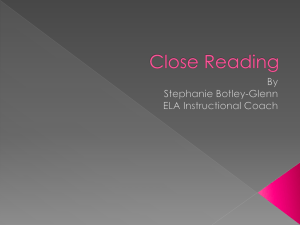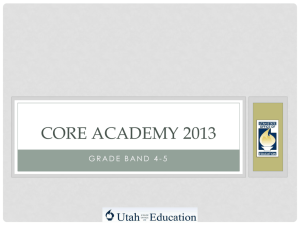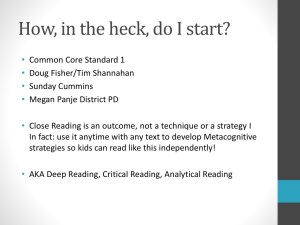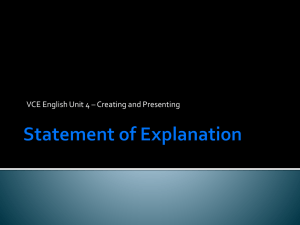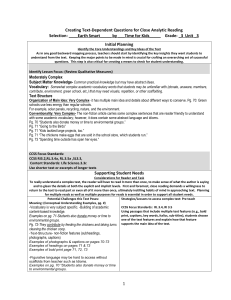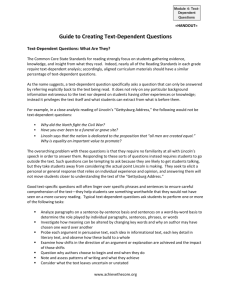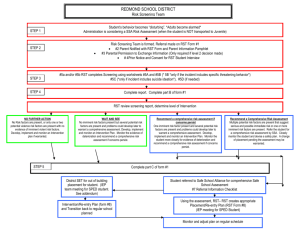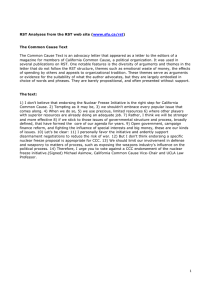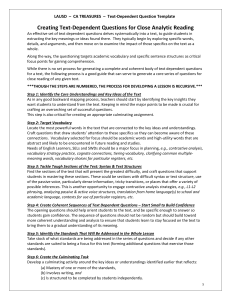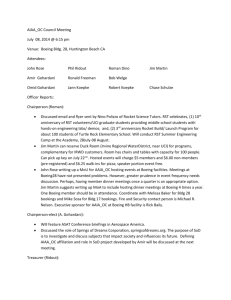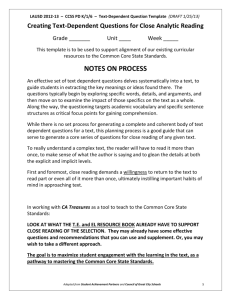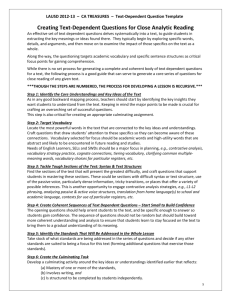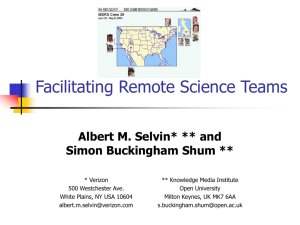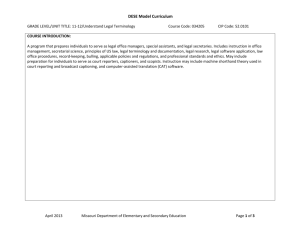The Mysteries of Mass
advertisement
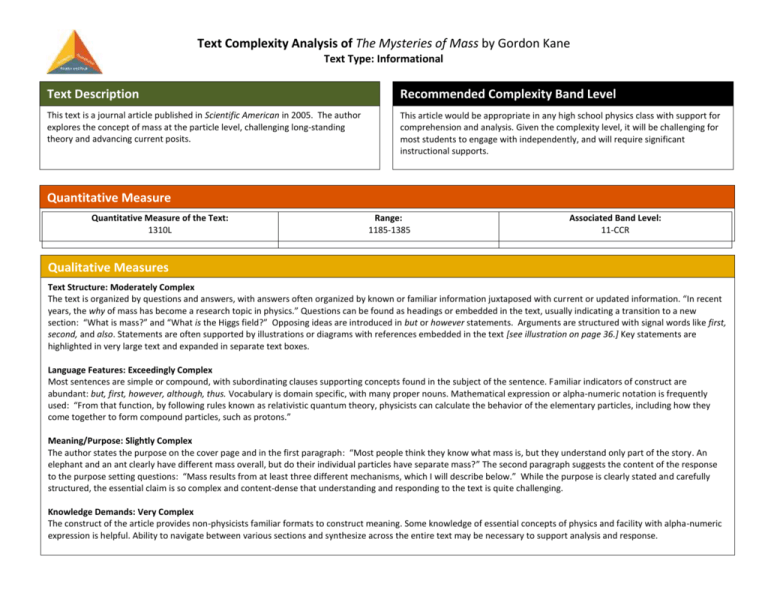
Text Complexity Analysis of The Mysteries of Mass by Gordon Kane Text Type: Informational Text Description Recommended Complexity Band Level This text is a journal article published in Scientific American in 2005. The author explores the concept of mass at the particle level, challenging long-standing theory and advancing current posits. This article would be appropriate in any high school physics class with support for comprehension and analysis. Given the complexity level, it will be challenging for most students to engage with independently, and will require significant instructional supports. Quantitative Measure Quantitative Measure of the Text: 1310L Range: 1185-1385 Associated Band Level: 11-CCR Qualitative Measures Text Structure: Moderately Complex The text is organized by questions and answers, with answers often organized by known or familiar information juxtaposed with current or updated information. “In recent years, the why of mass has become a research topic in physics.” Questions can be found as headings or embedded in the text, usually indicating a transition to a new section: “What is mass?” and “What is the Higgs field?” Opposing ideas are introduced in but or however statements. Arguments are structured with signal words like first, second, and also. Statements are often supported by illustrations or diagrams with references embedded in the text [see illustration on page 36.] Key statements are highlighted in very large text and expanded in separate text boxes. Language Features: Exceedingly Complex Most sentences are simple or compound, with subordinating clauses supporting concepts found in the subject of the sentence. Familiar indicators of construct are abundant: but, first, however, although, thus. Vocabulary is domain specific, with many proper nouns. Mathematical expression or alpha-numeric notation is frequently used: “From that function, by following rules known as relativistic quantum theory, physicists can calculate the behavior of the elementary particles, including how they come together to form compound particles, such as protons.” Meaning/Purpose: Slightly Complex The author states the purpose on the cover page and in the first paragraph: “Most people think they know what mass is, but they understand only part of the story. An elephant and an ant clearly have different mass overall, but do their individual particles have separate mass?” The second paragraph suggests the content of the response to the purpose setting questions: “Mass results from at least three different mechanisms, which I will describe below.” While the purpose is clearly stated and carefully structured, the essential claim is so complex and content-dense that understanding and responding to the text is quite challenging. Knowledge Demands: Very Complex The construct of the article provides non-physicists familiar formats to construct meaning. Some knowledge of essential concepts of physics and facility with alpha-numeric expression is helpful. Ability to navigate between various sections and synthesize across the entire text may be necessary to support analysis and response. Text Complexity Analysis of The Mysteries of Mass by Gordon Kane Text Type: Informational Considerations for Reader and Task Possible Major Instructional Areas of Focus (include 3-4 CCS Standards) for this Text: Below are factors to consider with respect to the reader and task: Potential Challenges this Text Poses: RST.11-12.3 - Evaluate various explanations for actions or events and determine which explanations best accords with textual evidence, acknowledging where the text leaves matters uncertain. Explain whether the author successfully provides responses to all of the questions he asks, evaluating the quality of evidence provided to support those responses. RST.11-12.5 - Analyze in detail how a complex primary source is structured, including how key sentences, paragraphs, and larger portions of the text contribute to the whole. Ask students to annotate the structure of this article. What are the main organizing forces? How does this structure help the reader digest the information the author puts forward? RST.11-12.7 - Integrate and evaluate multiple sources of information presented in diverse formats and media in order to address a question or solve a problem. Analyze the effectiveness of the graphics used to support the author’s argument. Include illustrations, text boxes, and diagrams to explain why particle mass remains a mystery. The text is colorful and some pages are very busy. Following the essential text around and through the various graphics may be a challenge. Differentiation/Supports for Students: Chunking the text for easier navigation: Help students tackle one section at a time, asking text-dependent questions about each section to ensure that they’ve understood that section before moving on to the next. Breaking this text up into pieces will prevent students from feeling overwhelmed. Ask students to capture the main ideas or points of each section in their own words. Annotation – read with highlighters to color code key concepts, supporting evidence, and critical vocabulary. Write paragraph summaries in the margins. Cut the graphics to place them with the text they support. The biggest challenge will be to support students in navigating the density of information in this article. Help them take ownership over the article by feeling like they can take it apart as needed. Text-Dependent Questions – Develop a small set of text-dependent questions for each chunk of the text that will ensure that students get the main points of each section before moving on to the next. Asking students to search for specific evidence in the text will help them further break down the information in the article. Glossary of terms – Because of the significant domain-specific vocabulary in this selection, it may be helpful to keep a running list of terms and their meanings as you unpack this text.
